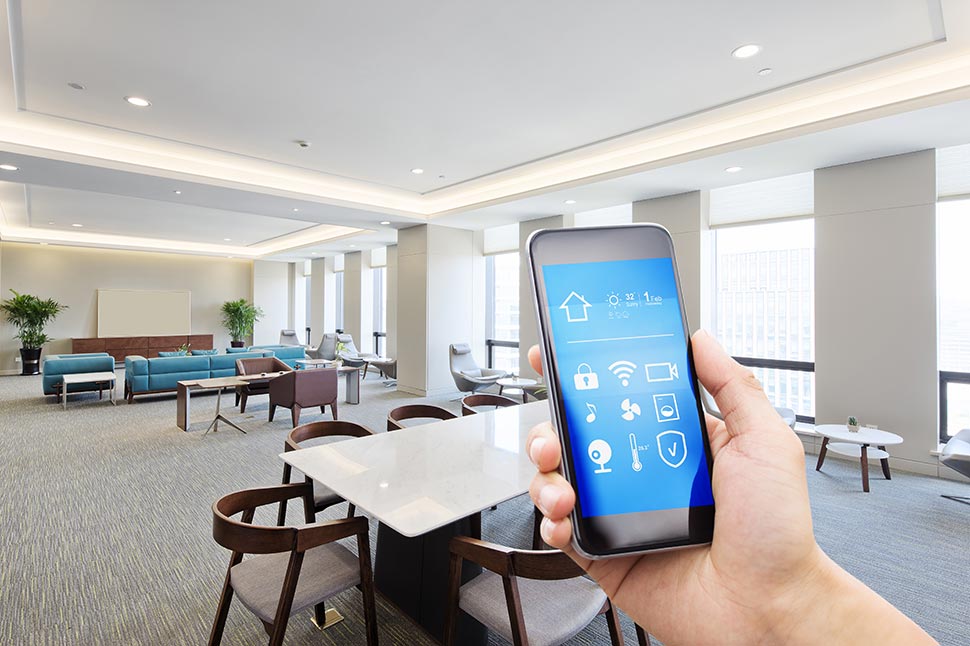July/August 2021 | Vol. 26 No. 4
 by Maria Marks, National Business Development Manager, Siemens
by Maria Marks, National Business Development Manager, Siemens
Maria Marks has been active in the fire life safety and security industry for more than 25 years. With a focus on the building design and construction industry, she promotes intelligent infrastructure to create safe smart buildings and communities.
Over the last year, the office has been redefined. And we have quickly learned to work remotely. Now we are returning to buildings, and our expectations have shifted. We are re-evaluating how space is used. Office space has changed over the years to adapt to different collaboration and management styles. The most recent shift has moved us from a mix of enclosed offices and cubicles to open space and large pods. With a need for rapid response and risk reduction, we now see a need for flexible space and a hybrid work environment. New technology enables building owners and occupants to meet these demands. Through systems integration it will be possible to ensure that conference rooms and workspaces are automatically set for the desired work environment upon reservation. For instance, if the meeting includes a presentation, the room can be set to a dimmer light with any audio-visual equipment powered on and ready to go. Building managers can also arrange for the temperature to be automatically adjusted based on occupancy.
New Customer Requirements
There is an increased focus on sustainability and healthy buildings. We are seeing an increase in requirements for net-zero buildings. A net-zero building uses the same amount of energy that it produces each year. But this shift does not come easily. Owners, consultants, and contractors are using building systems and green energy sources to meet these demanding requirements. Wind, solar energy, and energy storage systems such as lithium-ion batteries are examples of common energy solutions.
Building systems are also increasingly designed with a focus on reducing energy consumption. For example, motion detectors automatically turn off lights if the space is unused. Building management systems can be programmed to reach the desired heating/cooling setpoints in an energy-efficient manner rather than having systems running continuously or occupants reacting to temperature extremes.
There is also a renewed focus on healthy environments, which are known to promote better work conditions. Although this is not a new concept, recent challenges have highlighted indoor air quality. It is well known that conditioning spaces reduces health risks. It’s important to examine building air quality from a holistic standpoint and not only in isolation—this includes the air brought into the building, how it’s conditioned, what temperature and humidity setpoints are programmed for each space, etc. By using dedicated approaches to indoor air quality, one can protect people’s health and safety inside the building and increase productivity. However, a careful balance needs to take place, as simply increasing the rate of air changes may increase building energy consumption. Today’s building management systems can use sensors to set the appropriate air exchange rate while balancing energy concerns. These goals may be achieved through dedicated approaches to indoor air quality.

New Technology in Building Systems that Will Help Meet New Demands
Building systems have advanced with the use of increased sensors and new technology. For instance, some lighting systems now utilize Power over Ethernet (PoE) technology. Ethernet has become a standard cabling method for diverse building systems. Even NFPA 72 has a section on a shared Class N (Ethernet) network.
By integrating building systems to create a smart building on a converged network, it’s possible to leverage occupancy data from different sensors and systems to achieve energy efficiency and comfort for the occupants. This also eliminates redundancies of occupancy sensors and switches, and ultimately reduces the cost of ownership. With an integrated building management system, a building can now set the temperature in a space or call an elevator when an employee uses their access card to enter the lobby. Or in the event of an emergency, the operator may see the alarm shown on a graphical map, and the associated security cameras will be activated to show the live feed.

Emerging Technology Committee Activities
The NEMA SB Emerging Technology Committee is exploring the concept of a Life Safety Knowledge Portal to enhance lifesaving responses while reducing risks to first responders and building occupants. Conceptually, the portal will store building data and permit access to it to essential first responders during an emergency.
Building systems have access to a remarkable quantity of data, including smoke detector status, security cameras, in-building temperature gradients, emergency calls from occupants, and more. If presented clearly and accessed in real time, this information could enhance lifesaving responses while reducing risks to first responders and building occupants.
In April, key Members of the industry attended a workshop. These experts included first responders, representatives from the National Institute of Standards and Technology (NIST) and Institute of Electrical and Electronics Engineers (IEEE), and others. We posed questions including:
- What information would be of most use to first responders?
- How could this data be securely stored and easily accessed?
- Can it be connected to the Next Generation 911 technology?
It is important to start asking these questions now, as it may take a code cycle to formalize the concept and structure. Work has already begun through recent fire alarm code updates. The 2022 edition of
NFPA 72 permits remote access within parameters and adds a framework to follow for cybersecurity protection. Cybersecurity will remain an ongoing project discussion for the design, installation, ongoing maintenance, and use of the systems.
Additionally, it will be necessary to define the format for data management across all building systems. This includes capturing and storing the data from these diverse systems so that it is available when needed. One of the challenges we will face is deciphering the data, as the tags used for the metadata across different building systems may not match.
As we look to the future, technology will continue to play a role in creating an office space that is comfortable, accessible, and an extension of how we work and live. By sharing data across the diverse building systems, owners will be able to meet sustainability requirements and operating budgets. And in the event of an emergency, the building will be a resource to aid the first responders. A smart building is truly a safe building. ei